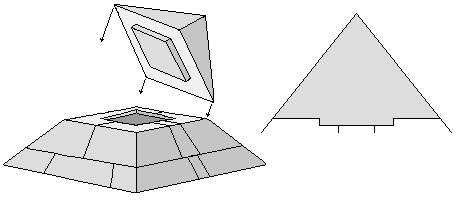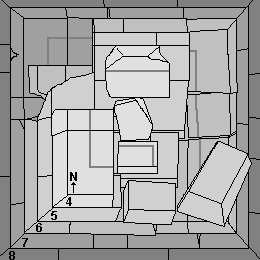www.cheops-pyramide.ch Copyright 2006 Franz Löhner and Teresa Zuberbühler
How were the pyramids built?
The apex (tip) of the pyramid with the pyramidion
 Terminology
Terminology
The uppermost piece or capstone of a pyramid is called "pyramidion" (plural pyramidia). The tip of a pyramid and also the tip of an obelisk is called ben-ben (benben, bnbnt, ben-benet) - this is the same word, that the ancient Egyptians used for a cone-shaped bread. In mathematical terms a pyramid is a three-dimensional figure made up of a base and triangular faces that converge on one point which is the vertex or apex of the pyramid.
 Importance of capping the pyramid with the pyramidion
Importance of capping the pyramid with the pyramidion
It is assumed, that to the Egyptians capping the pyramid with the pyramidion was of great importance, probably a sacred act - completing the building by placing the tip on the top. Probably the pharaoh, the high priests and the entire royal household were celebrating this important event with huge festivities.
On the wall painting of Djehutiotep at Deir El Bersheh, you can observe, that transporting major parts of a building (here a colossal statue) was associated with a large ceremony. The ancient Egyptians believed, that the sun god Re was crossing the sky on the solar barque (or barge), so the sledge was formed like a barque and the statue attached to it.
Using Franz Löhner's methods the pyramidion can be hauled up to the top of the pyramid in one continuous movement - the interrelation with the rising of the solar disc in the sky is obvious.
After putting the pyramidion in place on the top of the pyramid there are no further construction steps necessary.
|
Franz Löhner thinks, it is possible, that the outer surface of the pyramid was polished and then, the building was dedicated and in a sacred act the pyramidion was hauled in one continuous movement up the entire flank and put on top of the pyramid! Now the pyramid was completed. |
Afterwards, when all the tracks are dismantled and the protruding stone
bosses used to anchor the rope roll stations are bevelled the pyramid
becomes a insurmountable structure - a white abstract geometrical
symbol rising up into the sky with the sun daily traversing it!
![]() The outer casing stones of the pyramid
The outer casing stones of the pyramid
 How to solve the transport problems
How to solve the transport problems
With all ramp models, building the last 50 meters is specially difficult
if not impossible. Although building the last third of the pyramid only
uses 3 percent of the entire volume of stones [2],
the volume of the ramps is rising disproportionately. Up here at 100 meters
height it gets very narrow and much more difficult to maneuver the sledges
with the stones, so some ramp models use auxiliary constructions such
as small ramps, wooden stairs and levers. But even if these devices work
for the smaller stones used here (most stones here are 50 to 70cm high)
they don't solve the problem how to transport the large pyramidion up
to the top.
![]() Theories of pyramid ramp systems disproved
Theories of pyramid ramp systems disproved
With Löhner's rope rolls this problem can easily be solved, it is only necessary to make some additional provisions at the top of the pyramid.
| 1. | New | When the second last stone course is built, four special Tura stones are installed, where the rope rolls can be anchored slightly set off from the pyramid plateau. The outer stones are fitted and polished, so the pyramid is nearly finished with only the pyramidion missing. |
| 2. | New | About half a meter underneath and on the eastern and western side of the pyramid plateau, wooden platforms for the workers are installed. On the northern side a platform is built as well, but a meter lower. |
| 3. | New | The top of the pyramid is measured. The pyramidion is cut to such a shape, that it forms a tip with just the right angles. Then it is polished to perfection and carefully tied to the sledge (doctrine = the pyramidion is transported up on ramps or it is levered with wooden levers from one course up to the next every time a stone course was added. It is bevelled and polished after being set on top of the pyramid) |
| 4. | New | Up the pyramid flank only one track is left, with rope roll stations installed about every 30-37m distance. The pyramidion is hauled up in one continuous movement and without any stops. Now it can be placed on the apex (tip) of the pyramid (doctrine = zigzag ramps or ladder ramp for the last meters) |
| 5. | New | The wooden platforms are removed and while dismantling the tracks, the protruding Tura stones which served to anchor the tracks - 2 stones at each rope roll station - are bevelled and polished. Now the pyramid is finished (doctrine = after the pyramidion is placed on top, all the casing stones are bevelled and polished from the top down and the ramps are dismantled which requires again several years!) |
![]() The pyramid building yard - the center
of the construction project
The pyramid building yard - the center
of the construction project
![]() The outer casing stones of the pyramid
The outer casing stones of the pyramid
 Necessary preparations
Necessary preparations
For the last few stone courses the corner stones have to be cut with utmost precision and all stones have to be interlocked with care. Perhaps the last 10 meters of the pyramid were built entirely of white Tura-stones [2]. The pyramidion was probably interlocked with the last stone course with the help of a peg [1].
Pyramidion of Khafre's pyramid. Upper stone course after Lepsius. Illustration [7]
Khufu's pyramid is 146.59 meters high and its construction took several years, so some mistakes might have been made. Probably the angles of the ridge were just slightly different from the ideal seked of 5½ palms. So the top of the pyramid had to be measured exactly and all angles had to be determined. To be sure of the exact shape of the pyramidion, a so called falsework was made. A falsework is a frame made out of wood in the exact shape you want, like a one-to-one model. This frame is made on site, up on the pyramid, then brought back down to the building yard at the foot of the pyramid.
The pyramidion was probably delivered from the quarry only roughly shaped.Now
it the pyramidion is cut to just the right shape in a workshop (not on
top of the pyramid!). The wooden falsework is used as a precise model
so that the resulting stone forms a tip which perfectly fits on the top
of the pyramid.
![]() Wikipedia about falsework
Wikipedia about falsework
Then the pyramidion is polished to perfection. The stone block is canted, so the side which has to be polished was level. The grindstone is used many thousand times and the water carriers are busy filling the tub from where water trickles over the grinding surface. Quartz sand and emery and, if the pyramidion is made from granite, coarse wool is used to rub into the stone until it is gleaming.
 The last few meters
The last few meters
With increased height, the surface used for maneuvering and working on top of the pyramid frustum is much reduced. Since the volume of work is also reduced greatly, the tracks for the sledges can be dismantled one after the other, until for the last meters only one track system is in use. Thanks to the rope rolls even with a reduced working surface, no additional problems crop up. The outer Tura stones, including the last stone course just under the pyramidion, are polished.
Only a small area - approximately 15 by 15 meters - remain for the hauling team to shift the stones. To accomplish this, they install two additional rope rolls on the stones across from the tracks on the other side of the frustum at the edge. Hauling the stones around on the top of the frustum is done with the help of wooden levers.
For the last stone courses the corner stones are cut with utmost precision
and the ridges have to taper off to a perfect tip. All stones were interlocked
to give the apex (tip) as much stability as possible.
![]() Photo of the tip of Khufu's
pyramid / Tip of Khafre's
pyramid / photo
2
Photo of the tip of Khufu's
pyramid / Tip of Khafre's
pyramid / photo
2
 When
the second last stone course is built, four special Tura stones
are installed, so the rope rolls can be anchored slightly set off from
the pyramid plateau. Before the pyramidion is hauled up, the pyramid
plateau has to be completely free of any obstacles whatsoever.
This is very important, because the workers have to be able to maneuver
on the top. A temporary working platform made from wood
is installed to the east and west and about half a meter below the pyramid
plateau. On the northern side the platform is built about a meter lower.
The workers have to position themselves on the platforms on the side when
tilting and adjusting the pyramidion, no haulers are allowed to stand
on the plateau.
When
the second last stone course is built, four special Tura stones
are installed, so the rope rolls can be anchored slightly set off from
the pyramid plateau. Before the pyramidion is hauled up, the pyramid
plateau has to be completely free of any obstacles whatsoever.
This is very important, because the workers have to be able to maneuver
on the top. A temporary working platform made from wood
is installed to the east and west and about half a meter below the pyramid
plateau. On the northern side the platform is built about a meter lower.
The workers have to position themselves on the platforms on the side when
tilting and adjusting the pyramidion, no haulers are allowed to stand
on the plateau.
One to two meters under the edge of the frustum a rope is tautened around the pyramid and on both sides there are wedges to keep it in place. For safety reasons all workers and moving parts like tools or wooden planks are secured with lines attached to this rope.
 Preparations
Preparations
Placing the pyramidion on the top of the pyramid had to be painstakingly planned. Because hauling the pyramidion up the flank of the pyramid was most likely an important ceremony with profound religious significance, nothing was allowed go wrong. The supervisors responsible for finishing the pyramid planed to haul the pyramidion up the flank in one go, in one continuous movement with no stops and restarts until it would reach the top, and then planned to place it at its intended position straight away.
About 4 rope roll stations were already installed to overcome the 146
meters difference in height, a fifth station was built on the edge - so
about 500 haulers were needed in total. Hauling the heavy pyramidion (5-6
tons) up in one continuous movement implied using more haulers than usual
and a fast exchange of ropes and hauling teams at the intermediate rope
roll stations. So at each rope roll station additional hauling teams are
ready, so hauling the pyramidion up is accomplished slowly but with no
hesitation.
![]() Transport up the pyramid flank with
Löhner's rope roll
Transport up the pyramid flank with
Löhner's rope roll
The pyramidion has to be tied carefully to the sledge. This sledge is specially large and the pyramidion is tied to the sledge in such a way, that it protrudes in front (see illustration below). This is important because the ropes from the last rope roll station are attached to the cross-piece behind, so it is easier to tilt the sledge over the edge.
For two weeks the cross-pieces (which are gliding over the rails) are put with their lower side into a tub filled with oil and are lubricated with tallow.
Bracings and formworks are attached to the sledge, so the stone can't slip off when being hauled up. Any wood touching the polished stone is wrapped with cloth so nothing can damage the stone or diminish the luster.
The supervisors review together with the workers the whole process to make sure everybody knows what was expected of him. Of course the haulers used for this final feat are very seasoned workers, having hauled up thousands of stones over the years - every hand grip, every step has been mastered and any difficulties conquered. Nevertheless the pyramidion weights 5-6 tons and the usual stones at this height are much smaller and lighter (about 1m by 1m and 0.5m high weighting about 1.3 tons).
When hauling up this important final stone everything has to be in order, so all parts of the track system are controlled again, the ropes are exchanged for new ones, the rope rolls at the stations controlled and lubricated with grease, exactly positioned and wedged in. The rails are greased again, the anchorage of the framework is controlled and at some places the wedges are renewed.
 Positioning at the top
Positioning at the top
The area where the pyramidion is put has to be totally free of workers, tools or other obstacles. The hauling team (A) responsible for tilting the stone stands by on the temporary working platform at the northern side, where they sturdily brace against the flank of the pyramid. The workers with the levers are also standing on a somewhat higher platform to the east and west. While the hauling team start moving the pyramidion up, the workers responsible for tilting the stone get ready.
A pair of rope rolls are placed on special Tura stones slightly set off from the pyramid plateau, a second pair of rope rolls are installed at the edge at the rear. The rope goes from the fore rope roll to the rear rope roll and back again.
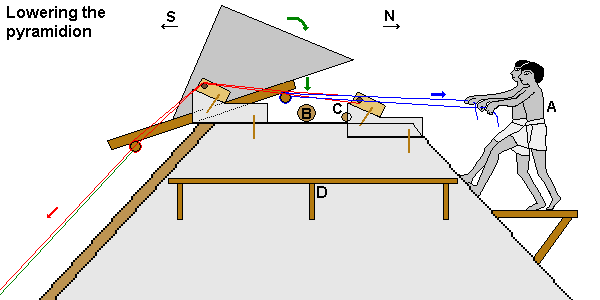
Illustration: Lowering the pyramidion with the help of the last rope roll station which is positions on the edge at the top of the frustum of the pyramid. A team of haulers / B thick round log / C thin round log / D platform. Workers with levers and those controlling an extra rope for tilting are not shown.
The sledge is now hauled up the flank in one continuous movement, passing by all the intermediate rope roll stations on the way until it reaches the second last rope roll station. Because the most difficult part starts - the pyramidion has to be tilted over the edge of the second last stone course and onto the top - the ropes have to be changed and specially arranged. The ropes (red) are attached to the rear cross piece of the sledge which is about a meter longer at the back. This is the rope that is used to actually haul up the sledge on the final leg.
Two hauling teams, one at the usual position on the sides of the track and an other smaller team hauling on an extra rope (green) are taking care, that the tilting of the pyramidion on the edge is done without any problems. They are standing on the two platforms D. A smaller team of workers is standing by on the lower wooden platform (A), they also have to help to control the tilting by hauling on an additional rope (blue). Several workers are positioned with levers on the eastern und western side, also standing on platforms.
When the sledge arrives on the edge, it is pulled further on, until it
is slightly protruding over the edge. Now it would normally tilt and hit
the edge. To avoid this, there is a beam (B) lying on
the top. When the pyramidion is lowered it rests on this beam and then
is slowly moved forwards until it rests on a second smaller beam (C).
Now the pyramidion is slowly moved to its intended position. With levers
the pyramidion is lifted a bit and then the beams underneath can be removed.
If done with precision, the pyramidion can be lowered exactly to its position
and lies flush on the top. Probably a peg helped to fit the pyramidion
and interlock it well with the rest of the stones.
![]() Löhner's rope roll
Löhner's rope roll
![]() Calculating the force and kinetic coefficient
of friction necessary
Calculating the force and kinetic coefficient
of friction necessary
Now all that has to be done is to remove the wooden platforms and to dismantle the tracks. The protruding Tura stones which served to anchor the tracks (2 stones at each rope roll station) are bevelled and polished. The pyramid is finished shortly after the pyramidion is set on its top!
|
This whole process was one of the most important part of the pyramid construction, a sacred act, and was certainly attended by Khufu and his royal household. Now imagine the pyramid workers slowly removing the wooden platforms and then one track segment after the other dismantled - above them a sheer white wall rising up to the apex, inaccessible for millennia to come! Now the pyramid becomes a perfect geometrical shape in dazzeling white, an abstract symbol! First standing by itself, then joined by more huge pyramids built by Khafre and then Menkaure. |
 The pyramidia of the pyramids in Giza
The pyramidia of the pyramids in Giza
Pyramidion of Khufu's pyramid:
The pyramidion of Khufu's pyramid is missing - the last 9 stone
courses (or more) have been removed, the pyramidion was probably toppled
and hasn't been found. The pyramidion of a large pyramid such as the pyramid
of Khufu weighted around 5 to 6 tons, was made from Tura limestone, granite
or diorite and was perhaps gold plated [2]. This
stone had to be cut to measure (taking into account, that slight errors
in measurement might have occurred and the top of the pyramid was not
exactly centered), specially burnished and polished.
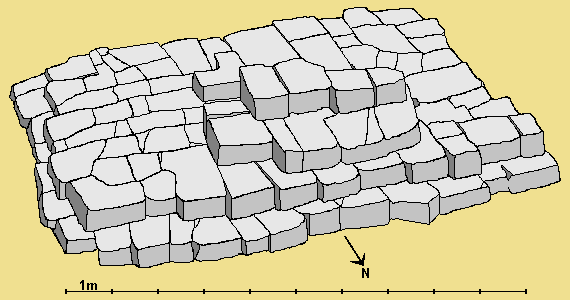
The top courses of the pyramid of Khufu after an aerial photography [8] - photo
Some archeologists [1] suggest, that the pyramids have a core with vertical tiers inside. But this kind of inner core should be visible at least at the top of the Khafre pyramid, where only 9 stone layers have been removed. More about the question of mantle or integral part.
Pyramidion of Khafre's pyramid:
The pyramidion of Khafre's' pyramid was never found. At the apex
(tip) of Khafre's pyramid remains of the outer casing stones are still
in place. Because only a few stone courses are missing, the dimension
of the pyramidion was calculated to be about 3 cubits (= 1.57m). The angles
of the pyramidion were deduced from the angles of the ridges and a slight
distortion has been discovered [8] probably due
to small errors in measurement while building. Actually this slight distortion
seems to also indicate, that the stones were bevelled and polished not
from the top down as most Egyptologists think, but as postulated on this
website, at the quarry. Photo
of the apex of Khafre's pyramid.
![]() The outer casing stones of the pyramid
The outer casing stones of the pyramid
![]() Alignment of the pyramids and controlling
the shape of the pyramid
Alignment of the pyramids and controlling
the shape of the pyramid
To topple a pyramidion you have to reach the tip of the pyramid. But this is not possible as long as the outer surface is smooth. Part of the "casing" of Khafre's pyramid seems to hang in midair since centuries, because the lower stones were removed. Even in 1639 the British John Greaves wrote, that the outer casing stones of Khafre's pyramid were intact except on the southern face [10]. So how was the pyramid toppled? There are no written sources - we can speculate, that a earth quake could possibly move the pyramidion and the top three stone layers - but it is also possible, that it was done by men.
| We calculate, that the topmost stone course (red - for colors mouse over) still visible on the apex of Khafre's pyramid is the forth upper course. So only two more stone courses and the pyramidion are missing. The stones of the fifth course (orange) have moved sideways at the southeastern corner. The northwestern corner can only be seen at the seventh course (light green). A small stone (pink) is left over from one more stone course, perhaps also belonging to the fourth course but moved to the middle. The pyramidion was probably interlocked with the last stone course with the help of a peg [5]. Indentations for pegs (gray) on the forth, sixth and seventh stone course can be distinguish on the aerial photos. The corner stones are all large (the largest stone of the forth course is about 2 x 1.5 meters). The stone courses were meticulously interlocked, the joints never lie on top of one another. This shows, that at least the last seven stone courses were thoroughly planned and each stone was fitted precisely - something which could only be done at the quarry - not on the small surface area up here at the top! |
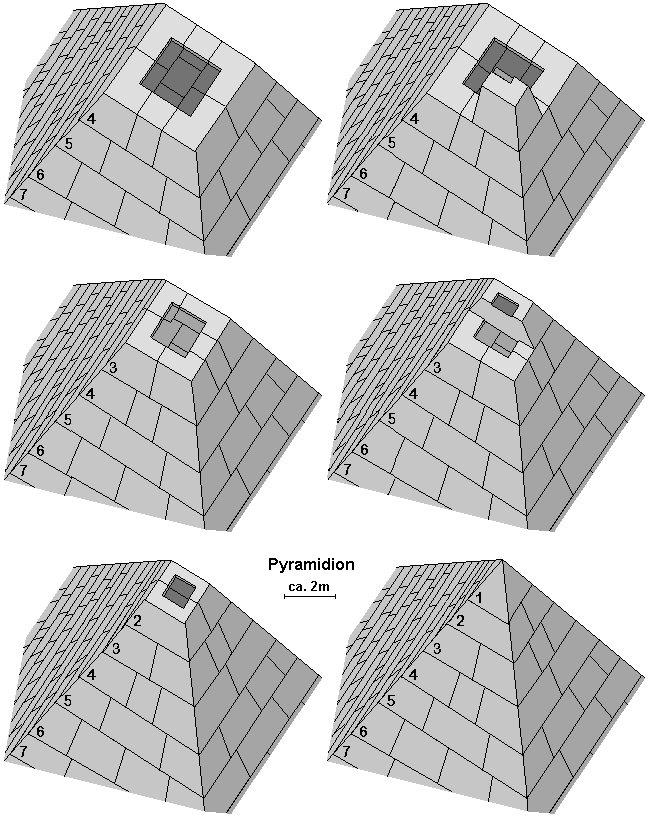
The last stone courses and the pyramidion of Khafre's pyramid (according to [1]).
You can see, that only a very small area of about 2 by 2 meters (assuming the pyramidion is about 4 cubits long and weights about 5 tons) is remaining for the hauling team to shift the stones.
About the pyramidion of Menkaure's pyramid nothing is known.
 What kind of pyramidia have been found?
What kind of pyramidia have been found?
Only a few pyramidia have been found, so we can only conjecture what
materials they were made from - probably limestone, granite and diorite.
From the Old Kingdom only pyramidia made from limestone are known, for
example the undecorated pyramidion
of the red pyramid (Sneferu) made from Tura limestone
and a limestone pyramidion from the satellite pyramids of Menkaure
(G3a and G1d). From the Middle Kingdom, pyramidia made from granite and
diorite are known, for example the well known pyramidion
of Amenemhat III in Dahshur which is made from black
granite with an engraving of the winged sun disk.
![]() Photos
of several pyramidia
Photos
of several pyramidia
![]() The pyramid of Khufu
and its chambers and shafts (about the satellite pyramids)
The pyramid of Khufu
and its chambers and shafts (about the satellite pyramids)
Pyramidion according to antique historians:
According to Agatharchides of Cnidus [9] an antique
Greek historian (208 B.C.) the pyramidion of the Great
Pyramid was 4 cubits high and made from a glittering metal, probably gold.
Diodor (Diodorus) Siculus [10] writes 100 years
later, that the lateral surface of Khufu's pyramid was 6 cubits wide near
the tip.
It has to be taken into consideration though, that as long as the surface
of the pyramid was intact, the apex (tip) of the pyramid could not be
reached and measured!
Number speculations:
If we use whole numbers (in Egyptian units of measurement) to calculate
the size of a pyramidion and if it should not be higher than 3 royal cubits
(=1.3m this is the height of a pyramidion found) and should have an angle
of inclination of 51.84° (pyramid of Khufu) we get the following possible
dimensions:
| Length of the pyramidion | Height of the pyramidion | Height of the lateral surface | Volume and weight |
| 88 fingers (3 cubits 1 palm = 1.64m) |
56 fingers (2 cubits = 1.08m) |
71 fingers | 0.96m² / 2.51t |
| 110 fingers (4 cubits = 2.09m) |
70 fingers (2.5 cubits = 1.31m) |
89 fingers | 1.90m² / 5.12t |
| 132 fingers (4 cubits 20 fingers = 2.47m) |
84 fingers (3 cubits = 1.57m) |
106 fingers | 3.19m² / 8.30t |
For these calculations a seked of 5½ palms or 22 fingers was used.
![]() Alignment of the pyramids and controlling
the shape of the pyramid
Alignment of the pyramids and controlling
the shape of the pyramid
 Sources
Sources
These methods for building the pyramids were first published 1993 in the book "Der Bau der Cheops-Pyramide" by Heribert Illig and Franz Löhner.
[1] D. Arnold Building
in Egypt
[2] R. Stadelmann Die grossen
Pyramiden von Giza
[3] W. Petrie The Pyramids and
Temples of Gizeh
[4] H. Illig und F. Löhner Der Bau
der Cheops-Pyramide
[5] P. Janosi Die Pyramidenanlagen
der Königinnen
[6] Diodorus (Diodor) Siculus Bibliotheca Historica chapter 63 Nileus
[7] Carl Richard Lepsius
[8] V. Maragioglio und C. Rinaldi
Architettura delle Piramidi Menfite. Le grande piramide di Cheope
[9] Agatharchides of Knidos Asiatica
[10] M. Lehner Geheimnis der Pyramiden
www.cheops-pyramide.ch Copyright 2006 Franz Löhner and Teresa Zuberbühler
